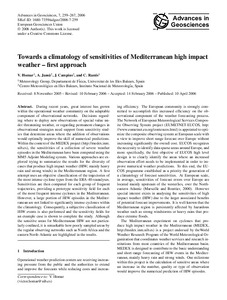Por favor, use este identificador para citar o enlazar este ítem:
http://hdl.handle.net/20.500.11765/11792
Towards a climatology of sensitivities of Mediterranean high impact weather – first approach
Registro completo de metadatos
| Campo DC | Valor | Lengua/Idioma |
|---|---|---|
| dc.contributor.author | Homar Santaner, Víctor | es_ES |
| dc.contributor.author | Jansà Clar, Agustí | es_ES |
| dc.contributor.author | Campins, Joan | es_ES |
| dc.contributor.author | Ramis, Clemente | es_ES |
| dc.date.accessioned | 2020-05-11T09:57:31Z | - |
| dc.date.available | 2020-05-11T09:57:31Z | - |
| dc.date.issued | 2006 | - |
| dc.identifier.citation | Advances in Geosciences. 2006, 7, p. 259–267 | es_ES |
| dc.identifier.issn | 1680-7340 | - |
| dc.identifier.issn | 1680-7359 | - |
| dc.identifier.uri | http://hdl.handle.net/20.500.11765/11792 | - |
| dc.description | This work has been partially funded by EUCOS, CICYT REN2002-03482 and CICYT CGL2005-05681 grants. | es_ES |
| dc.description.abstract | During recent years, great interest has grown within the operational weather community on the adaptable component of observational networks. Decisions regarding where to deploy new observations of special value under threatening weather, or regarding permanent changes in observational strategies need support from sensitivity studies that determine areas where the addition of observations would optimally improve the skill of numerical predictions. Within the context of the MEDEX project (http://medex.inm.uib.es), the sensitivities of a collection of severe weather episodes in the Mediterranean have been computed using the MM5 Adjoint Modeling system. Various approaches are explored trying to summarize the results for the diversity of cases that produce high impact weather (HIW; mainly heavy rain and strong winds) in the Mediterranean region. A first attempt uses an objective classification of the trajectories of the most intense cyclone types from the ERA-40 reanalyses. Sensitivities are then computed for each group of frequent trajectories, providing a prototype sensitivity field for each of the most frequent intense cyclones in the Mediterranean. However, a large portion of HIW episodes in the Mediterranean are not linked to significantly intense cyclones within the climatology. Consequently, a subjective classification of HIW events is also performed and the sensitivity fields for an example case is shown to complete the study. Although the sensitive areas for Mediterranean HIW are not particularly confined, it is remarkable how poorly sampled areas by the regular observing networks such as North Africa and the eastern North-Atlantic are highlighted in the results. | es_ES |
| dc.language.iso | eng | es_ES |
| dc.publisher | European Geosciences Union | es_ES |
| dc.rights | Licencia CC: Reconocimiento-NoComercial-CompartirIgual CC BY-NC-SA | es_ES |
| dc.subject | High impact weather | es_ES |
| dc.subject | MEDEX project | es_ES |
| dc.subject | ERA-40 | es_ES |
| dc.subject | Numerical weather forecasts | es_ES |
| dc.subject | Cyclones | es_ES |
| dc.title | Towards a climatology of sensitivities of Mediterranean high impact weather – first approach | es_ES |
| dc.type | info:eu-repo/semantics/article | es_ES |
| dc.relation.publisherversion | https://dx.doi.org/10.5194/adgeo-7-259-2006 | es_ES |
| dc.rights.accessRights | info:eu-repo/semantics/openAccess | es_ES |
| Colecciones: | Artículos científicos 2005-2009 | |
Ficheros en este ítem:
| Fichero | Descripción | Tamaño | Formato | ||
|---|---|---|---|---|---|
| adgeo-7-259-2006.pdf | 5,36 MB | Adobe PDF |  Visualizar/Abrir |
Los ítems de Arcimis están protegidos por una Licencia Creative Commons, salvo que se indique lo contrario.





